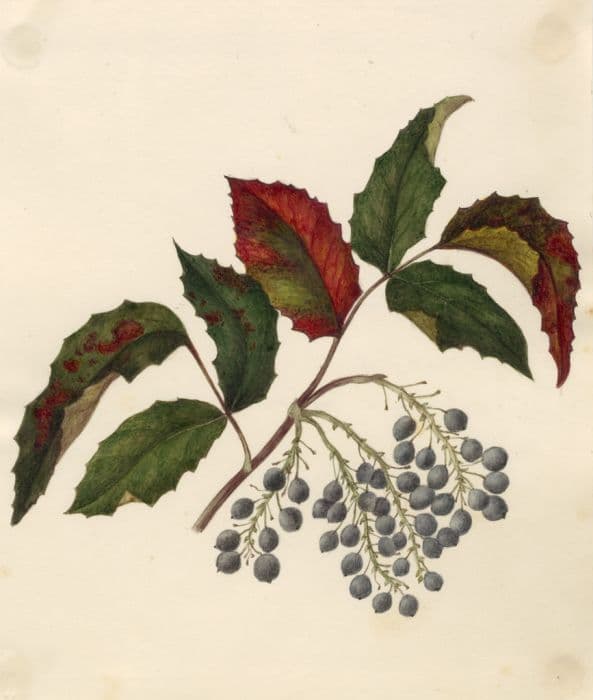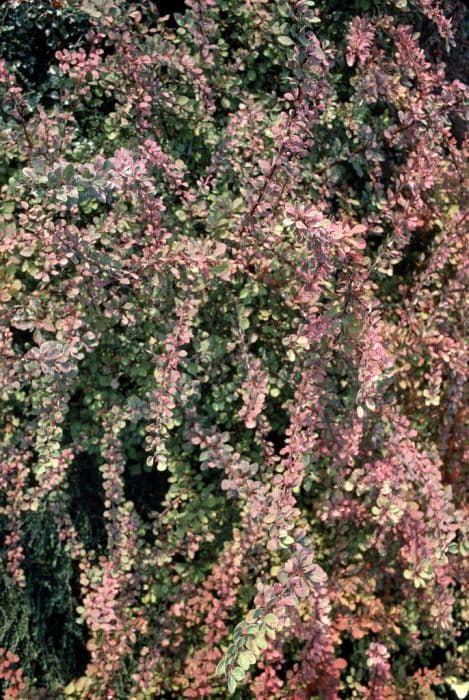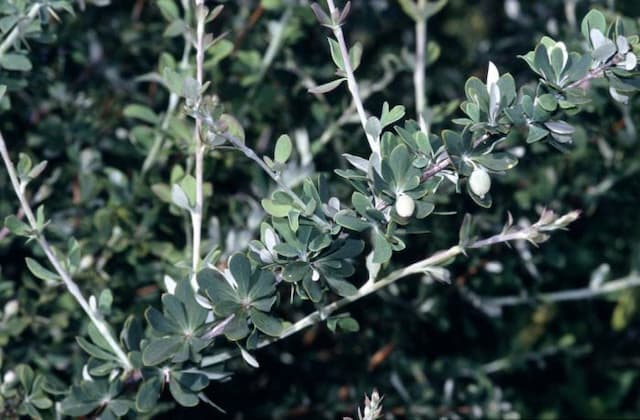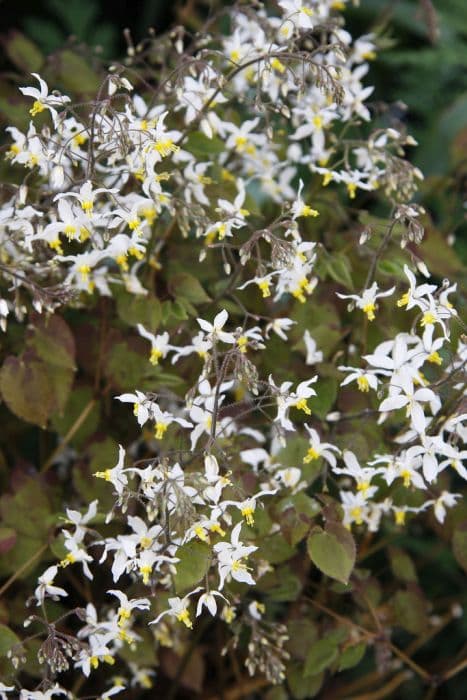Heavenly Bamboo Nandina domestica

ABOUT
Nandina domestica, widely known as heavenly bamboo, is a decorative plant known for its striking foliage, which changes color with the seasons. Despite its common name, it is not a true bamboo but rather a member of the berberis family. The leaves of the heavenly bamboo are compound, with multiple leaflets arranged in a pattern that somewhat resembles bamboo. These leaflets are lance-shaped and finely toothed. In its appearance, the heavenly bamboo often sports green leaves in the spring that turn to a vivid red or purple hue in the fall and winter, providing year-round visual interest in gardens. During the spring, the plant also produces clusters of small, white flowers that offer a delicate and airy look. These flowers typically give way to bright red berries by late summer or autumn, which can remain on the plants for an extended period and are often appreciated for adding a dash of color to the colder months. The overall form of the plant is upright and can be somewhat bushy, with a graceful texture and an elegant, tiered appearance contributed by the alternating arrangement of the leaves on the stems. Its beauty and ease of care make the heavenly bamboo a popular choice for ornamental garden landscapes, hedges, and screens.
About this plant
 Names
NamesFamily
Berberidaceae.
Synonyms
Heavenly Bamboo, Sacred Bamboo, Nandina.
Common names
Nandina domestica var. acuba, Nandina domestica f. acuminata, Nandina domestica var. amoena, Nandina domestica var. leucocarpa, Nandina domestica var. linearifolia, Nandina domestica var. macrocarpa, Nandina domestica var. marginata, Nandina domestica var. pygmaea, Nandina domestica f. rubrifolia, Nandina domestica var. striata, Nandina domestica var. umbraculifera, Nandina domestica var. vestita, Nandina domestica f. viridiflora, Nandina domestica var. viridiflora, Nandina domestica var. typica
 Toxicity
ToxicityTo humans
Heavenly bamboo contains compounds that can be toxic to humans if ingested. The berries contain hydrocyanic acid, which can lead to cyanide poisoning. Symptoms of poisoning may include nausea, vomiting, abdominal pain, diarrhea, weakness, difficulty breathing, and seizures. In severe cases, poisoning can be fatal. It is essential to avoid eating any parts of this plant, especially the berries.
To pets
Heavenly bamboo is toxic to pets, especially birds, cats, and dogs. The berries contain cyanogenic glycosides that can release hydrogen cyanide when ingested, leading to cyanide poisoning. Symptoms in pets may include vomiting, diarrhea, weakness, seizures, difficulty breathing, and even death in severe cases. It is crucial to prevent pets from consuming any part of this plant, with the berries posing the highest risk.
 Characteristics
CharacteristicsLife cycle
Perennials
Foliage type
Evergreen
Color of leaves
Varies
Flower color
White
Height
6-8 feet (1.8-2.4 meters)
Spread
2-4 feet (0.6-1.2 meters)
Plant type
Shrub
Hardiness zones
6-9
Native area
East Asia
Benefits
 General Benefits
General Benefits- Ornamental Appeal: Nandina domestica, commonly known as Heavenly Bamboo, adds ornamental value to gardens with its colorful foliage, which changes through the seasons, and clusters of bright red berries.
- Low Maintenance: Heavenly Bamboo requires minimal care once established, making it an ideal plant for gardeners of all skill levels.
- Drought Tolerance: It can withstand periods of dryness once it's well-established, reducing the need for frequent watering.
- Pest and Disease Resistance: Heavenly Bamboo is generally resistant to many pests and diseases, keeping it healthy without the need for chemical treatments.
- Versatility: It can be used in a variety of landscaping designs, including as a hedge, screen, or standalone specimen, offering flexibility in garden planning.
- Long-Living: Heavenly Bamboo is a long-living plant, providing a lasting presence in the landscape.
 Medical Properties
Medical PropertiesThis plant is not used for medical purposes.
 Air-purifying Qualities
Air-purifying QualitiesThis plant is not specifically known for air purifying qualities.
 Other Uses
Other Uses- Nandina domestica, commonly known as heavenly bamboo, serves as a barrier plant due to its dense growth, which can discourage foot traffic and provide privacy.
- The wood of heavenly bamboo is very strong for its size and has been used in the past for small woodworking projects and crafting walking sticks.
- In floral arrangements, the cut stems of heavenly bamboo, complete with their red berries, can add a splash of color that lasts long after other flowers may wilt.
- Heavenly bamboo can be used in themed gardens, such as Asian or Zen gardens, to provide an authentic aesthetic due to its Asian origin and bamboo-like appearance.
- The leaves of heavenly bamboo change color throughout the seasons, making it an excellent choice for gardeners looking to add year-round interest to their landscapes without intensive maintenance.
- During winter, the red berries of heavenly bamboo can serve as a natural food source for some bird species, though they should be offered with caution as they are toxic to some animals and humans when ingested in large quantities.
- Heavenly bamboo's resistance to deer browsing makes it a practical choice for gardens in areas where deer predation is a problem for other plants.
- The plant's ability to adapt to a wide range of soils, including problematic clay soils, makes it a useful option for soil stabilization in challenging areas of the landscape.
- Heavenly bamboo has been used in photographic and cinematic works depicting East Asia, as it provides an evocative and recognizable element of the region's natural flora.
- In some cases, heavenly bamboo's dense nature has been deployed to muffle sound, helping create quieter, more peaceful garden areas, especially in urban environments.
Interesting Facts
 Feng Shui
Feng ShuiThe plant Heavenly Bamboo is not used in Feng Shui practice.
 Zodiac Sign Compitability
Zodiac Sign CompitabilityThe plant Heavenly Bamboo is not used in astrology practice.
 Plant Symbolism
Plant Symbolism- Protection: Nandina domestica, commonly known as Heavenly Bamboo, is often associated with protection due to its sturdy and resilient nature, as well as the belief that plants with red berries can ward off evil spirits.
- Good Fortune: In some cultures, the bright red berries are seen as symbols of good luck and prosperity, making Heavenly Bamboo a plant that's often used in celebrations like New Year's.
- Eternal Life: The evergreen nature of Heavenly Bamboo, retaining its foliage throughout the seasons, represents longevity and the wish for a long life.
- Change and Transformation: Heavenly Bamboo changes color throughout the seasons, symbolizing life's constant change and personal transformation.
 Water
WaterHeavenly bamboo, which is the common name for Nandina domestica, prefers consistent moisture but does not like to be waterlogged. It should be watered deeply once a week, providing about 1 to 1.5 inches of water each time. This could translate to about 0.5 to 0.75 gallons for smaller plants or more for larger, established shrubs, depending on soil drainage and environmental conditions. During the hot summer months, you may need to water twice a week. In winter, reduce watering frequency to prevent root rot, especially if the plant is in a region where the soil stays moist for longer periods.
 Light
LightHeavenly bamboo prefers bright, indirect light when grown indoors and can tolerate full sun to partial shade outdoors. The ideal spot for this plant would be a location where it receives morning sunlight and afternoon shade, especially in hotter climates. However, it is versatile and can adapt to less than ideal lighting conditions, although its foliage coloration and blooming may be less vibrant in too much shade.
 Temperature
TemperatureHeavenly bamboo thrives in a wide range of temperatures but ideally should be kept in conditions between 50 and 85 degrees Fahrenheit. While it can survive temperatures as low as 0 degrees Fahrenheit, prolonged exposure to such cold can cause damage to the plant. The plant is hardy and can handle temperature fluctuations well, but it should be protected from extreme heat and cold for best growth and foliage color.
 Pruning
PruningPruning the Heavenly bamboo is important to maintain its shape, encourage bushiness, and remove any dead or diseased wood. The best time for pruning is in the late winter or early spring, before new growth starts. Light pruning can be done throughout the year to shape the plant or control its size. However, it's often recommended to be conservative with pruning, as this plant can take some time to recover from heavy cuts.
 Cleaning
CleaningAs needed
 Soil
SoilHeavenly Bamboo thrives in well-draining soil with a pH between 3.7 and 6.5. An ideal soil mix combines loamy garden soil, peat moss, and perlite in a 2:1:1 ratio.
 Repotting
RepottingHeavenly Bamboo should be repotted every 3 to 5 years, as it is not a fast-growing plant and tolerates being slightly root-bound.
 Humidity & Misting
Humidity & MistingHeavenly Bamboo prefers moderate humidity levels but is quite adaptable and can thrive in the average indoor humidity found in most homes.
 Suitable locations
Suitable locationsIndoor
Place Heavenly Bamboo in bright, indirect light and maintain moderate humidity.
Outdoor
Plant Heavenly Bamboo in partial shade and protect from strong winds.
Hardiness zone
Heavenly Bamboo is suitable for USDA zones 6-9.
 Life cycle
Life cycleHeavenly bamboo (Nandina domestica) begins its life cycle when a seed germinates, usually in spring, after a period of cold stratification that breaks seed dormancy. The seedling phase involves the development of a root system and the first shoots that push through the soil until the plant establishes a small rosette of leaves. During the vegetative growth stage, the plant develops a woody stem and a bushy form with compound, pinnate leaves that are often reddish when young and turn green as they mature. As the plant reaches maturity, which can take several years, it produces clusters of small white flowers in late spring or early summer. These flowers are followed by bright red berries that persist through winter, providing food for birds and facilitating seed dispersal. Finally, as a perennial, heavenly bamboo undergoes dormancy in winter months, with foliage sometimes turning reddish-purple before the cycle starts anew with spring growth.
 Propogation
PropogationPropogation time
Spring to Summer
Propogation: Nandina domestica, commonly known as heavenly bamboo, is typically propagated using softwood cuttings during late spring to early summer when the new growth is still somewhat flexible. To propagate, a cutting of about 4 to 6 inches (10 to 15 centimeters) is taken from a healthy stem, ideally with at least two to three leaf nodes. The lower leaves are removed, and the cut end is often dipped in rooting hormone to encourage root development. This cutting is then inserted into a well-draining potting mix or a mixture of peat and perlite, ensuring that at least one leaf node is below the surface. The pot needs to be kept in a warm location with indirect light and maintained moist until the roots develop, which can take several weeks. After rooting, the new plantlet can be gradually acclimatized to outdoor conditions before planting it out in the garden.









